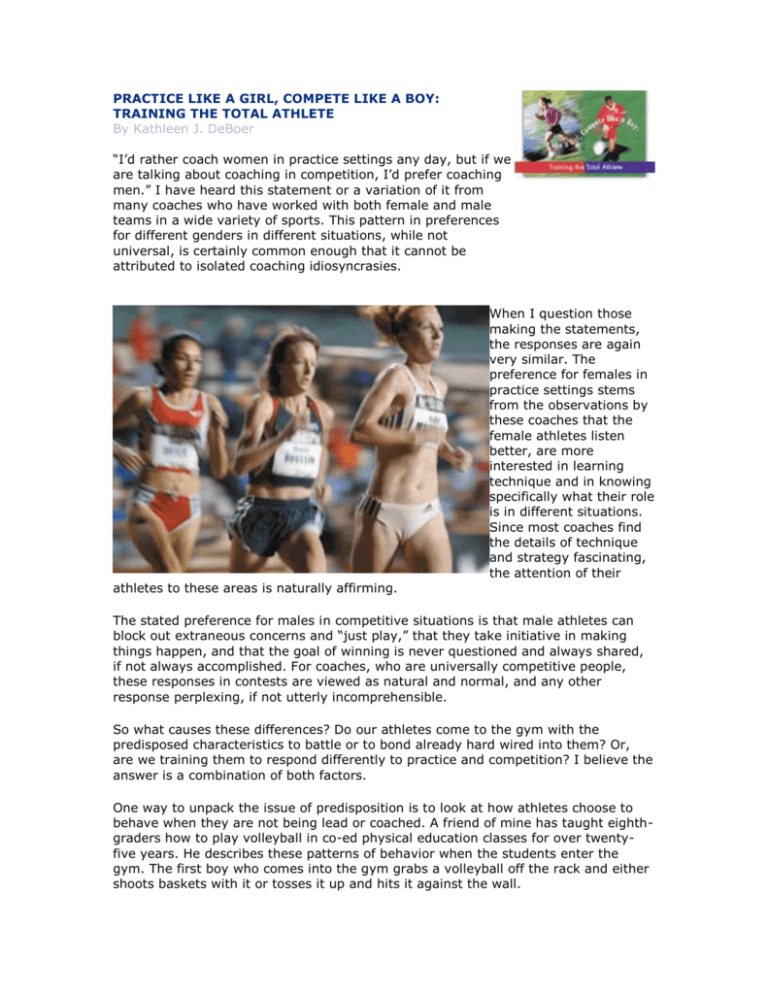Practice Like a Girl - Arlington Soccer Club
advertisement

PRACTICE LIKE A GIRL, COMPETE LIKE A BOY: TRAINING THE TOTAL ATHLETE By Kathleen J. DeBoer “I’d rather coach women in practice settings any day, but if we are talking about coaching in competition, I’d prefer coaching men.” I have heard this statement or a variation of it from many coaches who have worked with both female and male teams in a wide variety of sports. This pattern in preferences for different genders in different situations, while not universal, is certainly common enough that it cannot be attributed to isolated coaching idiosyncrasies. When I question those making the statements, the responses are again very similar. The preference for females in practice settings stems from the observations by these coaches that the female athletes listen better, are more interested in learning technique and in knowing specifically what their role is in different situations. Since most coaches find the details of technique and strategy fascinating, the attention of their athletes to these areas is naturally affirming. The stated preference for males in competitive situations is that male athletes can block out extraneous concerns and “just play,” that they take initiative in making things happen, and that the goal of winning is never questioned and always shared, if not always accomplished. For coaches, who are universally competitive people, these responses in contests are viewed as natural and normal, and any other response perplexing, if not utterly incomprehensible. So what causes these differences? Do our athletes come to the gym with the predisposed characteristics to battle or to bond already hard wired into them? Or, are we training them to respond differently to practice and competition? I believe the answer is a combination of both factors. One way to unpack the issue of predisposition is to look at how athletes choose to behave when they are not being lead or coached. A friend of mine has taught eighthgraders how to play volleyball in co-ed physical education classes for over twentyfive years. He describes these patterns of behavior when the students enter the gym. The first boy who comes into the gym grabs a volleyball off the rack and either shoots baskets with it or tosses it up and hits it against the wall. The first girl who enters the gym sits down on a bleacher to wait for her friends. The next boy who enters the gym generally engages with the first boy. They start playing short court over the volleyball net or engage in a game of one-on-one at the basketball goal. The second girl who enters the gym may get a ball off the rack and sit down next to the first girl or she may sit down in a different place on the bleachers. As more boys enter the gym, the games they are playing either expand or multiply. After a number of girls are in the gym they will get in a circle and pass and set the ball around the circle, laughing and talking as they exchange the ball. This differentiation is not universal, meaning there are girls that will display the characteristics typical for boys and boys who sit rather than engage, but they are the rare exceptions. The teacher reported to me that this pattern of gendered behavior has not changed for the twenty-five years he has been teaching volleyball to his classes. When choosing unsupervised interaction, the males choose competitive play, the females choose cooperative play. What happens when athletes are being coached? The 1990 Olympic Sports Festival was held in Chapel Hill, North Carolina. The eight men’s and women’s volleyball teams trained at Carmichael Gymnasium and an auxiliary facility. Bill Neville, a veteran coach with broad experience working with both males and females at both the elite and beginning levels, was the head of the volleyball delegation. In that role he spent considerable time observing the practices of the various coaching staffs. He made the following generalization about the training: the women’s teams, regardless of the gender of the coaching staff, spent a lot more time on technique and positioning drills than the men’s team; the men’s teams spent a lot more time in competitive, game-like drills than the women’s teams. I tucked the comment away for further reflection and observation because I was curious as to whether this tendency was peculiar to volleyball or held true across various team sports. When I returned to my college administrative post, I watched a variety of teams in practices to evaluate Neville’s hypothesis. The pattern he had observed in the volleyball practices held true for our basketball teams, our baseball/softball teams, and our soccer teams. Like the volleyball team practices, the women’s teams spent more time drilling on positioning, and repetitive techniqueoriented sequences; the men’s teams spent more time in head-to-head, competitive, results-oriented sequences. Since most of those coaching at the collegiate level had spent all of their time coaching either men or women, the coaches were unaware that this difference in training methods was so prevalent. At our institution only men coached the men’s teams but both men and women were in head and assistant positions with the women’s teams. As with the Olympic Sports Festival, only the gender of the athletes had an impact on the nature of the practice activities, not the gender of the coach. When I asked our coaches to reflect on the difference, the most common speculation was that the female athletes did not have the same physical skills in terms of movement, jumping ability and power as the male athletes, and, therefore, good technique was more critical to their success in playing the game. Shortly after these conversations I went to watch a friend coach his son’s six-year- old basketball team. When we entered the gym the boys were engaged in a variety of activities, some competing with each other by shooting long shots from outside the three point line, others playing H O R S E, still others trying to dribble without having another child steal the ball. The coach started the organized part of the practice with a few dribbling drills. The boys engaged in these exercises so lackadaisically that the coach stopped the drill and scolded them harshly, pointing out that dribbling was an essential skill to playing the game and they should pay attention to their method. Next he introduced a shooting drill. My friend began by explaining to his charges how to hold the ball in their hands, where to position it in relation to their bodies and how their hands should look on follow-through. During this explanation the boys fiddled and nudged each other, rarely looking at the coach. As soon as he gave them the go-ahead to practice this technique, they ran to the baskets and immediately started playing a game to see who could make the most baskets in the shortest period of time. Shortly thereafter, about fifteen minutes into the sixty minute workout, the coach divided the boys into teams for competitive drills, scrimmaging first in three-on-two fast break situations and progressing to five-on-five drills. These six-year-olds had no skills or movement abilities whatsoever, yet they spent most of their practice time in competitive, game-like progressions. My next opportunity for observation was at the Women’s Volleyball World Championships in Sao Paolo, Brazil, when I accompanied our national team as an advisor. Our practice times frequently overlapped with those of the other women’s teams. During the course of the two weeks I watched the silver medalist Brazilian team and several of the Asian teams in training sessions. These were the best women’s volleyball teams in the world, full of elite athletes with 15-20 years of high-level training and competition. They were, for the most part, above average jumpers with great body control and movement skills. Their practices, however, were amazingly technique oriented. They worked for long periods of time on footwork drills for blocking and transitioning from defense to offense. They spend considerable time on serving and passing drills. Only occasionally, for a few minutes at the end of a training session, did I observe anything that resembled a scrimmage or competitive exchange. These back-to-back observations of a beginning boy’s team engaged mostly in game-like activity and elite level women’s teams engaged mainly in technique training made me question the rationalizing lore I had been given by my peers as to the reasons for the gender differences in training regiments. The truth is that we as coaches are training our teams to their strengths because they are more cooperative and easy to deal with when engaged in activities in which they are comfortable. By our methods we reinforce what they already do well—teach females cooperative play, teach males competitive play. What we must realize, however, is that by our focus on technique, positioning and tactics we short-change our female athletes. We don’t subject them regularly to the uncomfortable stresses of competition. In the same vein, by our focus on battle, rivalry and proving oneself in training males, we leave them under-prepared also. They don’t get exposed to the difficult discipline needed to learn stress-proof technique or the repetition necessary to refine integrated tactics. To make a female team more competitive, we must practice competing. We must accept that the “me versus you” nature of a contest can be difficult for those who choose cooperative play when left to their own devices. For females, then, competitiveness must be taught and rehearsed. On the other hand, the male worldview grounded in proving ones self in opposition to others does not lend itself to the restraint of repetitive drilling. For males, then, the discipline to train, to learn proper technique must be taught and rehearsed. Each of you at this point can cite examples of elite athletes in your sport who are exceptions to these stereotypes—athletes who are both rigidly disciplined and insanely competitive. Yet I venture you could make a much longer list of those who didn’t quite make it because they were accomplished in only one half of the equation. The unanswered question for coaches is: how much competing do you put into your training if you are coaching women, or how much drilling do you demand if you are coaching men? It’s a tricky question. Each coach must evaluate the capacity for anxiety-producing activity among his or her athletes. My observation is that the younger the athletes the lower their tolerance for unpleasant experiences. Their primary motivation for engaging in the sport is to “have fun.” More mature athletes realize that periods of stress in training are part of the process in pursuing athletic excellence. I’ve also seen that, in most cases, a major jump shift from current practice does not work. Radical shifts make athletes edgy and confused about the goals of training. They quickly lose the sense of enjoyment they get from participation. The coaches of female teams who have the most success with teaching competitiveness are verbal and straightforward about what they are doing and why. Instead of assuming their athletes know how to compete, they make the practice of competing a regular, disciplined, and evaluated part of a workout. They also verbally deconstruct the inevitable conflicts that result from forcing their athletes into the uncomfortable situation of battling against each other. They accept the strife as part of the learning process. Finally and very importantly, they are attuned to the level of anxiety on their team so they can quickly revert to calming, process-oriented drills when necessary. Those who failed at teaching competitiveness plunged their teams into a mano-amano struggle without explanation or debriefing. The resultant fretfulness and disruption of team chemistry is generally disastrous to relationships among the players themselves and with the coach. The feminine ability to put emotions into words and the penchant to problem-solve verbally makes authentic communication between coach and athletes, and among the athletes themselves a prerequisite for success in training a female team to compete. Basketball’s Rick Pitino is the coach I have observed who had the most success with training males in repetitive, technique-specific, non-competitive sequences. He did this by separating his technical training from his team training. His morning sessions were individual—one or two athletes at a time, short—20 minutes, and frequent— four times per week. The focus was completely on technique—shooting the three, cross over dribble, stutter step and accelerate, head/ball fake and shoot, free throws, etc. The athlete was corrected each time he performed a technique incorrectly regardless of the result of his efforts. I observed a session one day in which a player missed 90% of his shots. The coach running the drill stood where he could only see the player’s form, not whether he made the basket or not. His comments were directed at the prescribed shooting form, which was correct most of the time. The coach said nothing about the misses. The sessions were also at game speed and very efficient. The athlete was breathing hard, yet aerobically, most of the time and, depending on his position, took between 250 and 400 shots per session. The main reason for the success of this training regiment is the individual nature of the sessions. The athlete was working only to satisfy the coach and the soul focus of the coach was the technical accuracy of a particular movement. The absence of rivalry and very clear feedback patterns allowed for concentration on method rather than outcome. Unlike the successful female practices, there was no conversation and no explanation. The mundanity of the individual training was numbing, even to me as a casual and occasional observer. But the effectiveness is also clear. Pitino’s players are known at the professional level for their excellent fundamentals and healthy self-confidence in their abilities. Their technical efficiency has also been said to mask physical limitations allowing them a couple of years or a season as a professional that they might not otherwise have had. Training complete athletes will not happen automatically. It takes purposeful attention by the coach to the part of successful competing that is difficult for them. Females must be taught, through frequent repetition, how to benefit from and be comfortable with head to head competition. Males must be taught, through daily rehearsal, how to benefit from and be comfortable with repetitive sequences focused on technique and tactics. Without knowledge of each gender’s predispositions, coaches easily gravitate toward a training regiment that reinforces that gender’s strengths. The results are frustrated coaches and semi-prepared athletes. Just as we take responsibility for all other aspects of training, coaches must be accountable for teaching their athletes either the competitive fire (female) or the technical discipline (male) that is essential for athletic success. Kathleen DeBoer is the author of the book “Gender and Competition: How Men and Women Approach Work and Play Differently” and is currently serving as the Executive Director of the American Volleyball Coaches Association. http://coaching.usolympicteam.com/coaching/kpub.nsf/v/2Apr06




